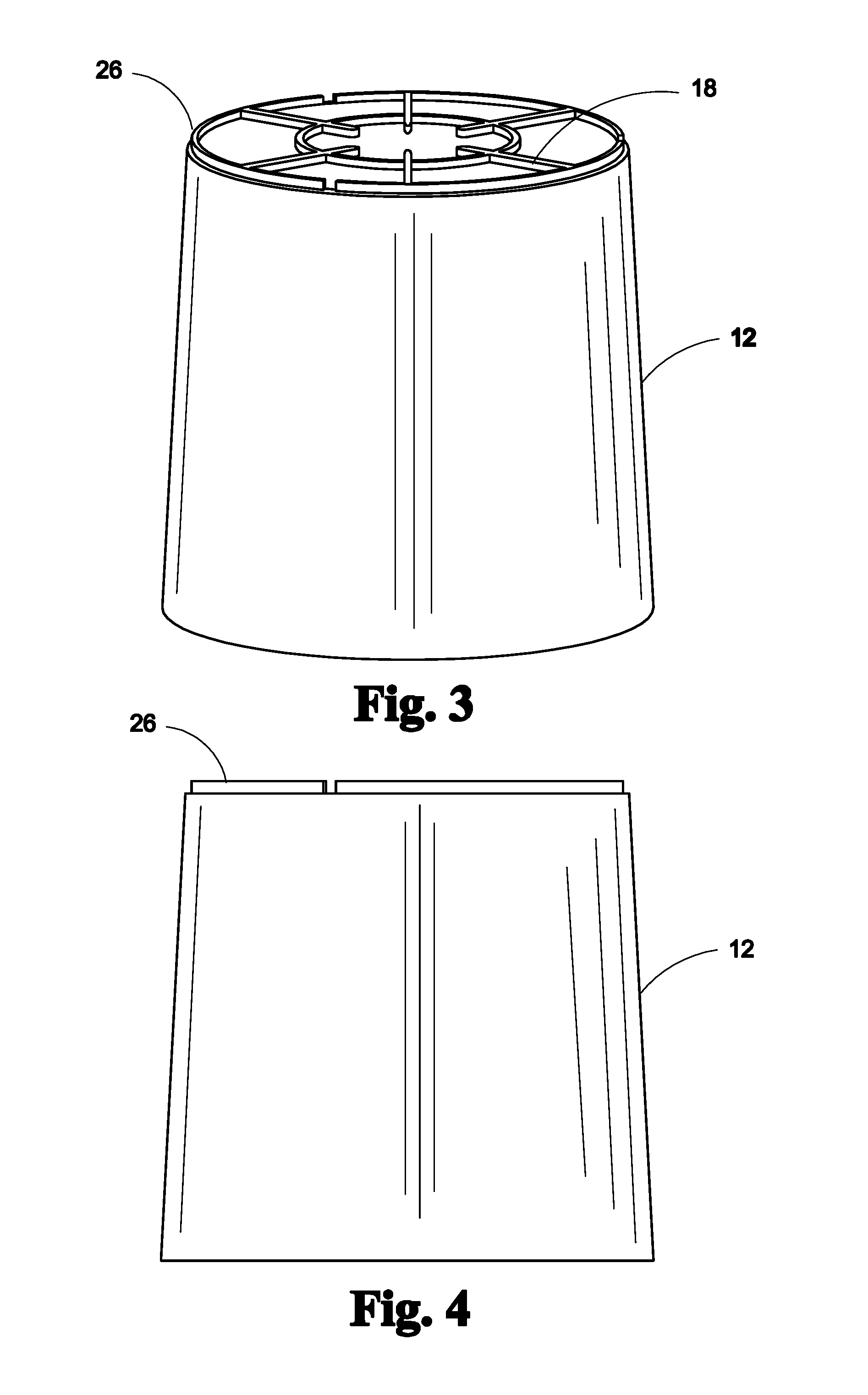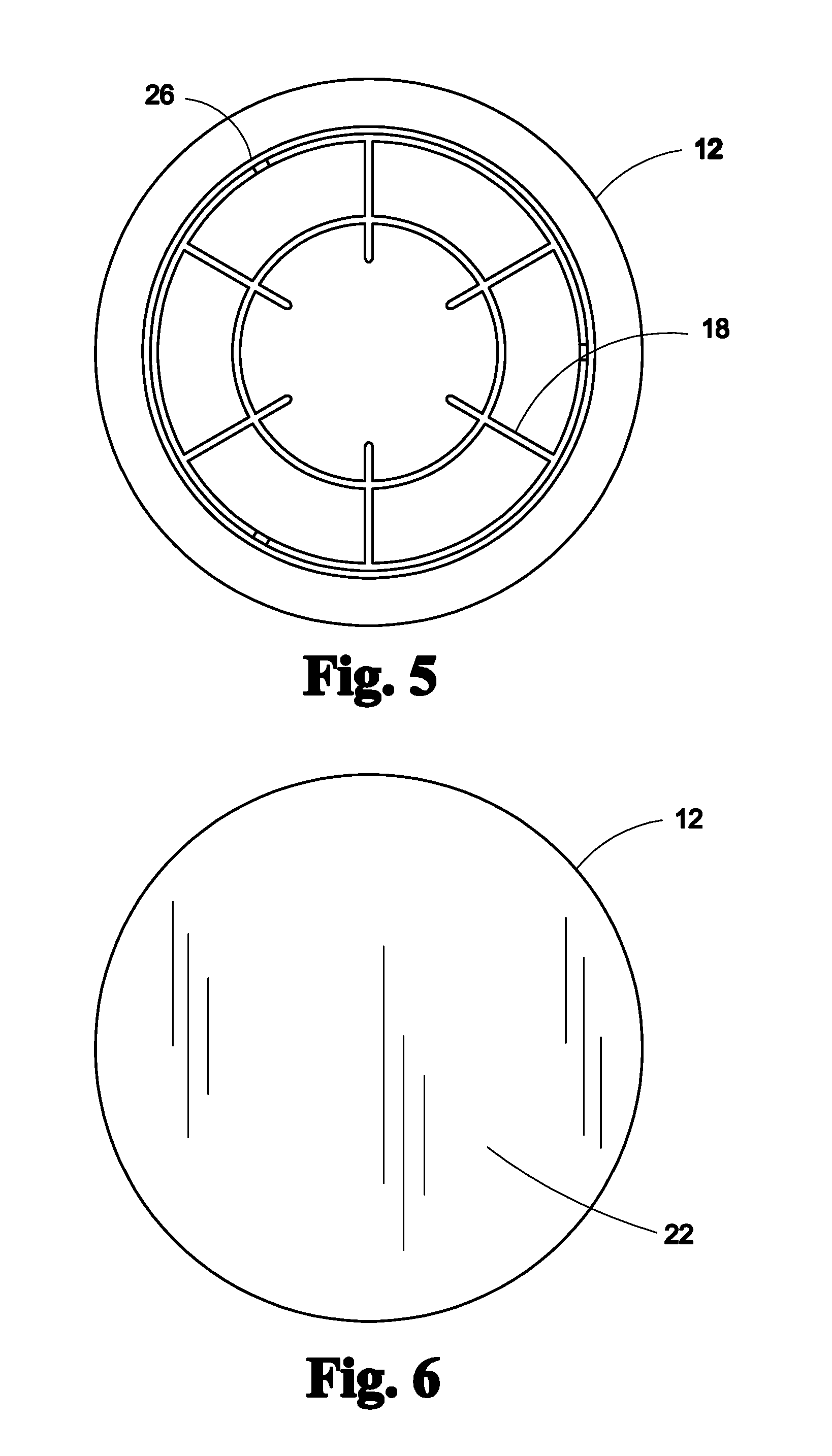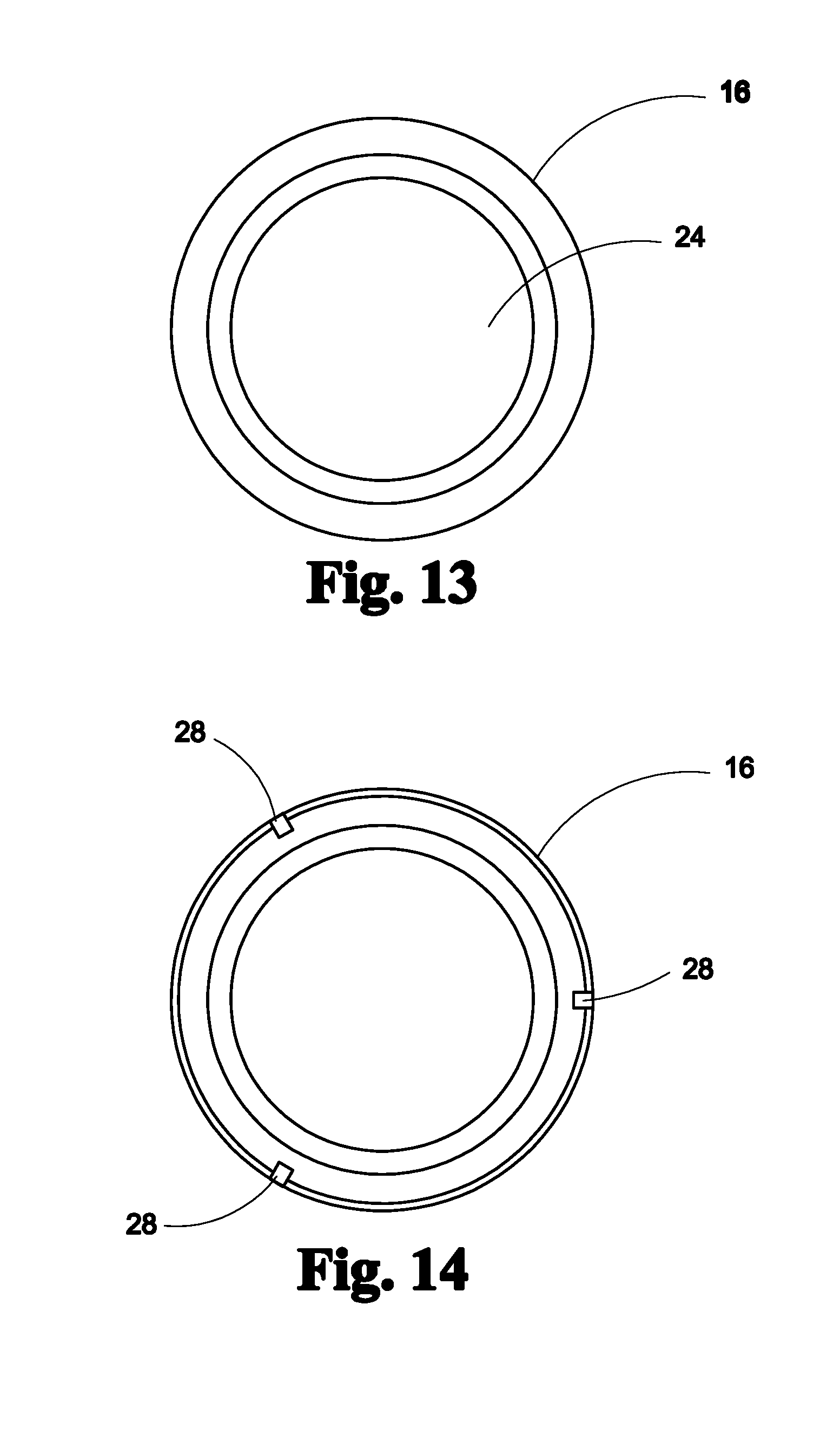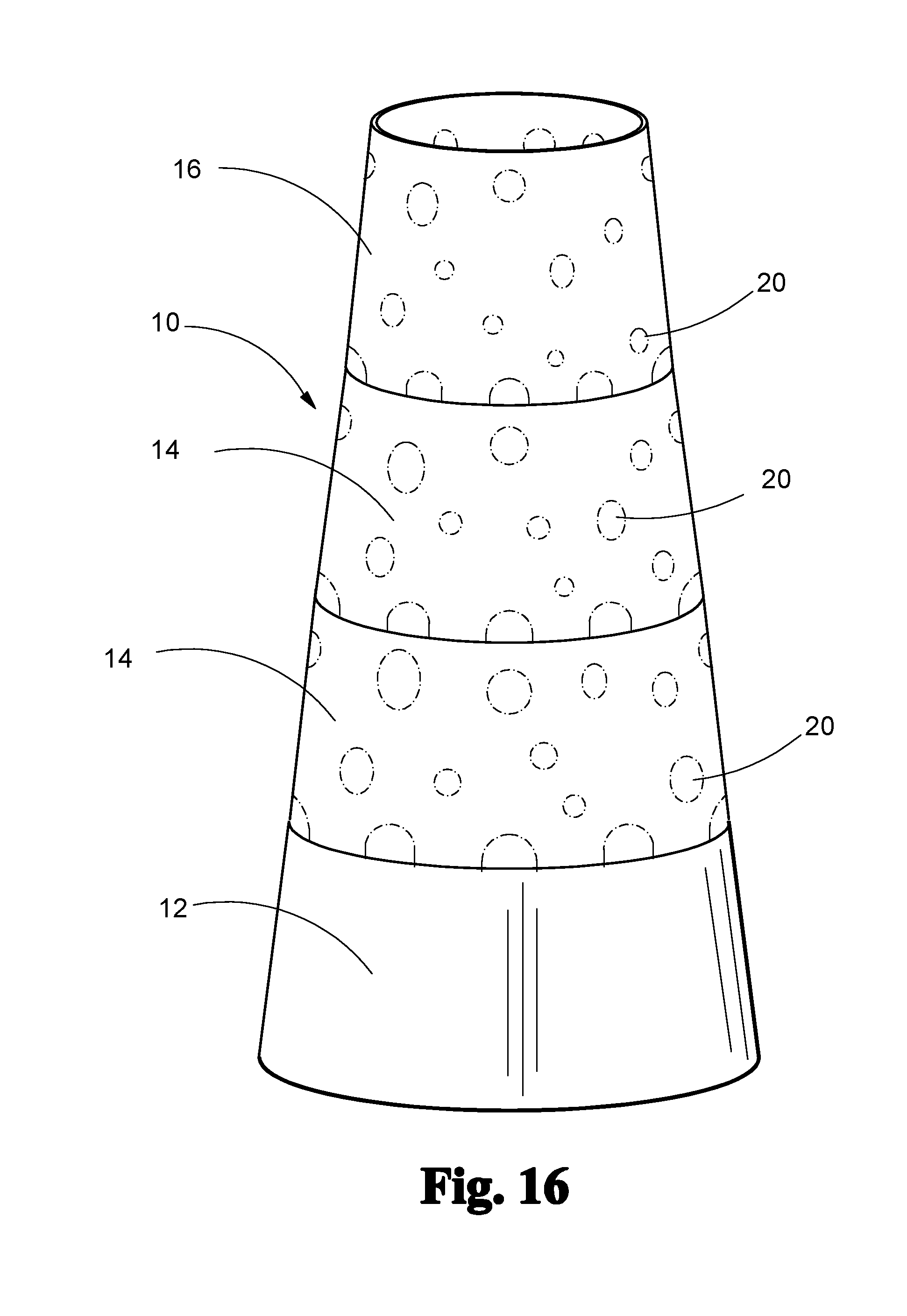Segmented Vase
van Smirren; Karin
U.S. patent application number 16/176531 was filed with the patent office on 2019-02-28 for segmented vase. The applicant listed for this patent is Karin van Smirren. Invention is credited to Karin van Smirren.
| Application Number | 20190059617 16/176531 |
| Document ID | / |
| Family ID | 64315754 |
| Filed Date | 2019-02-28 |












View All Diagrams
| United States Patent Application | 20190059617 |
| Kind Code | A1 |
| van Smirren; Karin | February 28, 2019 |
SEGMENTED VASE
Abstract
A segmented vase adapted for use to display fresh cut or artificial floral arrangements. The segmented floral vase is formed from a plurality of vase segments that may be stacked or joined to form a vase having a desired height for holding a floral arrangement. In a preferred embodiment, the segments may be nested, when not in use, to reduce the space required for storage of the vase. The plurality of vase segments may be formed with a frusto-conical sidewall. The segments may include a base segment, at least one intermediate segment, and a top segment. The segments may be joined in one or more of a snap fit, an interference fit, a threaded connection, or a tab and slot arrangement.
| Inventors: | van Smirren; Karin; (Potomac, MD) | ||||||||||
| Applicant: |
|
||||||||||
|---|---|---|---|---|---|---|---|---|---|---|---|
| Family ID: | 64315754 | ||||||||||
| Appl. No.: | 16/176531 | ||||||||||
| Filed: | October 31, 2018 |
Related U.S. Patent Documents
| Application Number | Filing Date | Patent Number | ||
|---|---|---|---|---|
| 29576106 | Aug 31, 2016 | D834447 | ||
| 16176531 | ||||
| Current U.S. Class: | 1/1 |
| Current CPC Class: | A47G 7/06 20130101; A47G 2007/066 20130101; A47G 7/07 20130101 |
| International Class: | A47G 7/07 20060101 A47G007/07 |
Claims
1. A segmented vase, comprising: a plurality of vase segments having a frusto-conical sidewall defining an interior cavity, a top opening, and a bottom opening, wherein a top end of a subjacent segment is dimensioned to interconnect with a bottom end of a superjacent vase segment.
2. The segmented vase of claim 1, wherein the plurality of vase segments comprises: a base segment, the base segment having a base joining the frusto-conical sidewall to define an interior, liquid containment reservoir; at least one intermediate segment, connectable to a top end of the base segment; and a top segment connectable to a top end of the at least one intermediate section.
3. The segmented vase of claim 1, wherein the plurality of vase segments are configurable in a nested stored condition.
4. The segmented vase of claim 1, further comprising: a plurality of apertures defined in the frusto-conical sidewall of one or more of the at least one intermediate segment and the top segment, the plurality of apertures.
5. The segmented vase of claim 2, further comprising: a divider defined in one or more of the base segment or the intermediate segment, the divider having a plurality of ribs extending radially inwardly from an inner face of the frusto-conical sidewall, and a ring interconnecting the plurality of ribs.
6. The segmented vase of claim 1, further comprising: a joining surface between the top end of the subjacent segment and the bottom end of the superjacent vase segment.
7. The segmented vase of claim 6, wherein the joining surface comprises: an annular flange dimensioned to interconnect with a shouldered recess.
8. The segmented vase of claim 7, wherein the annular flange and the shouldered recess are joinable in a snap fit configuration.
9. The segmented vase of claim 7, wherein the annular flange and the shouldered recess are joinable in a threaded configuration.
10. The segmented vase of claim 7, wherein the annular flange and the shouldered recess are joinable with an interference fit.
11. The segmented vase of claim 1, further comprising: at least one lid dimensioned to be coupled to a bottom end of one or more of the plurality of segments.
Description
CROSS-REFERENCE TO RELATED APPLICATION
[0001] This application is a continuation of U.S. patent application Ser. No. 29/576,106, filed Aug. 31, 2016, the contents of which are herein incorporated by reference.
BACKGROUND OF THE INVENTION
[0002] The present invention relates to decorative vases for holding floral arrangements.
[0003] Floral arrangements, whether made with fresh cut flowers or with artificial floral elements come in a wide variety of sizes and shapes. It is often a challenge to find a vase with the appropriate dimensions to hold the floral arrangement. This situation often requires that a variety of variously sized vases be available to display the floral arrangement. When not in use, the vases take up considerable storage space. For some, limited storage space may precluded the vases from being stored, which can lead to premature disposal of the vase while it is still suitable for its intended use.
[0004] As can be seen, there is a need for an improved floral display vase that can accommodate a variety floral arrangements and may be stored in a reduced volume configuration.
SUMMARY OF THE INVENTION
[0005] In one aspect of the present invention a segmented vase is disclosed. The segmented vase includes a plurality of vase segments having a frusto-conical sidewall defining an interior cavity, a top opening, and a bottom opening, wherein a top end of a subjacent segment is dimensioned to interconnect with a bottom end of a superjacent vase segment. The plurality of vase segments may include a base segment, the base segment having a base joining the frusto-conical sidewall to define an interior, liquid containment reservoir. At least one intermediate segment is connectable to a top end of the base segment. A top segment is connectable to a top end of the at least one intermediate section.
[0006] In a preferred embodiment, the plurality of vase segments are configurable in a nested stored condition. A plurality of apertures may be defined in the frusto-conical sidewall of one or more of the at least one intermediate segment and the top segment. A divider may defined in one or more of the base segment or the intermediate segment, the divider having a plurality of ribs extending radially inwardly from an inner face of the frusto-conical sidewall, and a ring interconnecting the plurality of ribs.
[0007] The plurality of segments include a joining surface between the top end of the subjacent segment and the bottom end of the superjacent vase segment. The joining surface may include an annular flange dimensioned to interconnect with a shouldered recess. The annular flange and the shouldered recess may be joinable in a snap fit configuration. In other embodiments, the annular flange and the shouldered recess are joinable in a threaded configuration. The annular flange and the shouldered recess may also be joinable with an interference fit.
[0008] The segmented vase of the present invention may also include at least one lid dimensioned to be coupled to a bottom end of one or more of the plurality of segments.
[0009] These and other features, aspects and advantages of the present invention will become better understood with reference to the following drawings, description and claims.
BRIEF DESCRIPTION OF THE DRAWINGS
[0010] FIG. 1 is a perspective view of an embodiment of a three segment segmented vase according to aspects of the present invention.
[0011] FIG. 2 is an exploded perspective view of the segmented vase.
[0012] FIG. 3 is a perspective view of a base segment.
[0013] FIG. 4 is a side elevation view of a base segment.
[0014] FIG. 5 is a top plan view of a base segment.
[0015] FIG. 6 is a bottom plan view of a base segment.
[0016] FIG. 7 is a perspective view of an intermediate segment.
[0017] FIG. 8 is a side elevation view of an intermediate segment.
[0018] FIG. 9 is a top plan view of an intermediate segment.
[0019] FIG. 10 is a bottom plan view of an intermediate segment.
[0020] FIG. 11 is a perspective view of a top segment.
[0021] FIG. 12 is a side elevation view of a top segment.
[0022] FIG. 13 is a top plan view of a top segment.
[0023] FIG. 14 is a bottom plan view of a top segment.
[0024] FIG. 15 is a perspective view of the segmented vase in use with a floral arrangement.
[0025] FIG. 16 is a perspective view of a four segment embodiment of a segmented vase.
[0026] FIG. 17 is a perspective view of a threaded base element.
[0027] FIG. 18 is a side elevation view of a threaded base element.
[0028] FIG. 19 is a perspective view of a threaded intermediate element.
[0029] FIG. 20 is a side elevation view of a threaded intermediate element.
[0030] FIG. 21 is a top plan view of a threaded top element.
[0031] FIG. 22 is a bottom plan view of a threaded top element.
[0032] FIG. 23 is a perspective view of a threaded top element.
[0033] FIG. 24 is a side elevation view of a threaded top element.
[0034] FIG. 25 is a top plan view of the assembled segmented vase.
[0035] FIG. 26 is a bottom plan view of the assembled segmented vase.
[0036] FIG. 27 is a perspective view of the assembled segmented vase with a floral arrangement.
[0037] FIG. 28 is a side sectional view of the segmented vase in an assembled condition.
[0038] FIG. 29 is a side sectional view of the segmented vase in a nested storage condition.
[0039] FIG. 30 is a side sectional view of a lid.
[0040] FIG. 31 is a perspective view of an alternative embodiment of a segmented vase.
DETAILED DESCRIPTION OF THE INVENTION
[0041] The following detailed description is of the best currently contemplated modes of carrying out exemplary embodiments of the invention. The description is not to be taken in a limiting sense, but is made merely for the purpose of illustrating the general principles of the invention, since the scope of the invention is best defined by the appended claims.
[0042] Broadly, embodiments of the present invention provide a segmented vase adapted for use to display fresh cut or artificial flow arrangements. The segmented floral vase is formed from a plurality of vase segments that may be stacked or joined to form a vase having a desired height for holding a floral arrangement. In a preferred embodiment, the segments may be nested, when not in use, to reduce the space required for storage of the vase.
[0043] As seen in reference to the drawings of FIGS. 1-13, the segmented vase 10 may include a plurality of segments 12, 14, 16 that may be stacked or joined to form a vase for holding a floral arrangement. The plurality of segments may include a base element 12 defined by a frusto-conical side wall. If the segmented vase 10 is being configured to carry fresh cut flowers, the base element has a base 22 joined to the frusto-conical sidewall so that a volume of water may be carried within for nourishment of the fresh cut flowers.
[0044] A top end of the base may include a divider 18 to provide separation of the stems of the flowers and to facilitate maintaining their position within the floral arrangement. The divider 18 may include a plurality of ribs extending radially inwardly from the frusto-conical side wall. The plurality of ribs may be joined by a ring element to provide additional separation for the stems and support for the plurality of ribs. A top end of the bottom segment 14 may have an annular flange 26 for interconnection with a superjacent vase segment. The annular flange 26 may have one or more notches to receive a locking tab 28 of protruding from a bottom end of the subsequent vase segment.
[0045] An intermediate segment 14 has a frusto-conical sidewall, a top opening and a bottom opening. In some embodiments, a plurality of apertures 20 may be defined in the sidewall for receiving the stems of the floral arrangement. A bottom end of the intermediate segment may have one or more locking tabs 28 to cooperatively engage with the annular flange 26 of a subjacent segment.
[0046] As with the base segment 12, the intermediate segment may have a divider 18 to provide separation of the stems of the flowers and to facilitate maintaining their position within the floral arrangement. The divider 18 may include a plurality of ribs extending radially inwardly from the frusto-conical side wall. The plurality of ribs may be joined by a ring element to provide additional separation for the stems and support for the plurality of ribs.
[0047] A top end of the intermediate segment may have an annular flange 26 for interconnection with a superjacent vase segment. A bottom end of the intermediate segment 14 may include an annular shouldered recess that is adapted to receive the annular flange 26 of a preceding segment. In some embodiments, the annular flange 26 is received in one of an interference fit, a snap fit, a threaded interconnection. In other embodiments, the annular flange 26 may have one or more notches to receive the locking tab 28 protruding from the bottom end of the subsequent vase segment. One or more intermediate segments 14 may be provided, wherein each has a progressively smaller diameter at each of the bottom end and the tope end of the segment 14.
[0048] A top segment 16 is defined by a frusto-conical sidewall having a top opening 24 and a bottom opening. The top segment 16 may also include a plurality of apertures 20 for receiving the stem of one or more flowers. A bottom end of the top segment 16 may have an annular shouldered recess that is adapted to receive the annular flange 26 of a subjacent intermediate segment 16. In some embodiments, the annular flange 26 is received in one of an interference fit, a snap fit, a threaded interconnection with an annular shouldered recess of a preceding segment.
[0049] As seen in reference to the drawings of FIGS. 16-28, an alternative embodiment of the segmented vase is shown. The segmented vase includes a base segment 12, one or more intermediate segments 14, and a top segment 16. The plurality of segments may be defined by a frusto-conical side wall. If the segmented vase 10 is being configured to carry fresh cut flowers, the base element 12 has a base 22 joined to the frusto-conical sidewall so that a volume of water may be carried within for nourishment of the fresh cut flowers. A top end of the bottom segment 12 may have an annular shouldered recess 25 for interconnection with a subsequent vase segment. An annular flange 26 of an intermediate segment 14 may be received in one of an interference fit, a snap fit, or a threaded interconnection with the annular shouldered recess 25 of the base segment 12. Alternatively, the annular shouldered recess 25 may have one or more locking tabs 28 for interconnection with a bottom end of the subsequent vase segment.
[0050] One or more intermediate segments 14 have a frusto-conical sidewall, a top opening and a bottom opening. In some embodiments, a plurality of apertures 20 may be defined in the sidewall for receiving the stems of the floral arrangement. A bottom end of the intermediate segment may have one or more locking tabs 28 to cooperatively engage with the annular flange 26 of a subjacent segment.
[0051] As with the base segment 12, the intermediate segment may have a divider 18 to provide separation of the stems of the flowers and to facilitate maintaining their position within the floral arrangement. The divider 18 may include a plurality of ribs extending radially inwardly from the frusto-conical side wall. The plurality of ribs may be joined by a ring element to provide additional separation for the stems and support for the plurality of ribs. A top end of the one or more intermediate segments 14 may have an annular shouldered recess 25 for interconnection with a subsequent vase segment. An annular flange 26 of an intermediate segment 14 or a top segment 16 may be received in one of an interference fit, a snap fit, or a threaded interconnection with the annular shouldered recess 25 of the base segment 12. Alternatively, the annular shouldered recess 25 may have one or more locking tabs 28 for interconnection with a bottom end of the subsequent vase segment. The one or more intermediate segments 14 may be provided, wherein each has a progressively smaller diameter at each of the bottom end and the tope end of the segment 14.
[0052] A top segment 16 is defined by a frusto-conical sidewall having a top opening 24 and a bottom opening. The top segment 16 may also include a plurality of apertures 20 for receiving the stem of one or more flowers. A bottom end of the top segment 16 may have an annular flange 26 that is adapted to be received in the annular shouldered recess 25 of a subjacent base segment 12 or an intermediate segment 16. In some embodiments, the annular flange 26 is received in one of an interference fit, a snap fit, a threaded interconnection with an annular shouldered recess of a preceding segment.
[0053] As seen in reference to FIG. 29, illustrating the segmented vase 10 in a storage condition, the base segment 12 is configured to receive the accompanying intermediate 14 and top 16 segments in a nested relationship. In the storage condition, the segmented vase 10 of the present invention occupies a small storage volume relative to the assembled vase.
[0054] FIG. 30 illustrates a lid 30 that is adapted to be sealingly joined with a bottom end one of an intermediate segment 14 or a top segment 16. One or more lids 30 may be provided with each of the one or more lids 30 dimensioned to a respective bottom end of the intermediate segment 14 or top segment 16 to provide a vase 10 that may have a height less than that of the fully assembled segmented vase 10. The lid 30 thus permits a variety of vase sizes depending upon the length and size of the flower arrangement carried therein. As will be appreciated, one or more vase segments 12, 14, 16 may be positioned in an inverted orientation to provide a vase 10 having a narrow base and a wider top opening. In this instance, the lid 30 may be dimensioned to sealingly join with a top end of the vase segment 12, 14, 16.
[0055] As seen in reference to FIG. 31, the frusto-conical segments 12, 14, 16 may be formed with a waved or arcuate sidewall configured to interconnect for an in-use condition and nest within each other when disassembled for storage. Likewise, the segments 12, 14, 16 may be joined with a post 31 and receiver 32, defined on an interior sidewall of the segment 12, 14, 16 such that the segments are snap-fit, or have a tab and slot arrangement. In this instance, the apertures 20 may be defined by a separation between adjacent segments 12, 14, 16.
[0056] The segmented vase, or one or more segments thereof, may be used as would other vases to contain floral arrangements. The segmented vase may also be utilized for planting bulbs and seeded flowers, herbs, and other decorative plants. Floral foam inserts may also be provided within the interior cavity of the segmented vase to facilitate the creation of decorative floral arrangements.
[0057] It should be understood, of course, that the foregoing relates to exemplary embodiments of the invention and that modifications may be made without departing from the spirit and scope of the invention as set forth in the following claims.
* * * * *
D00000

D00001

D00002

D00003

D00004

D00005

D00006

D00007

D00008

D00009

D00010

D00011

D00012

D00013

D00014

D00015

D00016

D00017

D00018

XML
uspto.report is an independent third-party trademark research tool that is not affiliated, endorsed, or sponsored by the United States Patent and Trademark Office (USPTO) or any other governmental organization. The information provided by uspto.report is based on publicly available data at the time of writing and is intended for informational purposes only.
While we strive to provide accurate and up-to-date information, we do not guarantee the accuracy, completeness, reliability, or suitability of the information displayed on this site. The use of this site is at your own risk. Any reliance you place on such information is therefore strictly at your own risk.
All official trademark data, including owner information, should be verified by visiting the official USPTO website at www.uspto.gov. This site is not intended to replace professional legal advice and should not be used as a substitute for consulting with a legal professional who is knowledgeable about trademark law.